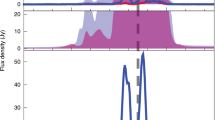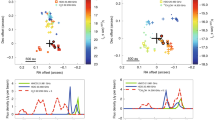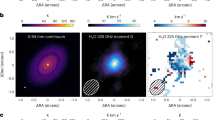Abstract
ACTIVE galactic nuclei are thought to be powered by gas falling into a massive black hole; the different types of active galaxy may arise because we view them through a thick torus of molecular gas at varying angles of inclination1. One way to determine whether the black hole is surrounded by a torus, which would obscure the accretion disk around the black hole along certain lines of sight, is to search for water masers, as these exist only in regions with plentiful molecular gas. Since the first detection2 of an extra-galactic water maser in 1979, they have come to be associated primarily with active galaxies, and have even been used to probe the mass of the central engine3. Here we report the detection of a water giga-maser in the radio galaxy TXFS2226 –184. The strength of the emission supports a recently proposed theory of maser pumping4 that allows for even more powerful masers, which might be detectable at cosmological distances. Water masers may accordingly provide a way to determine distances to galaxies outside the usual distance ladder, providing an independent calibration of the Bubble constant3,5.
This is a preview of subscription content, access via your institution
Access options
Subscribe to this journal
Receive 51 print issues and online access
$199.00 per year
only $3.90 per issue
Buy this article
- Purchase on Springer Link
- Instant access to full article PDF
Prices may be subject to local taxes which are calculated during checkout
Similar content being viewed by others
References
Barthel, P. D. Astrophys. J. 336, 606–611 (1989).
Dos Santos, P. M. & Lépine, J. R. D. Nature 278, 34–35 (1979).
Miyoshi, M. et al. Nature 373, 127–129 (1995).
Neufeld, D. A. & Maloney, P. R. Astrophys. J. 447, L17–L20 (1995).
Greenhill, L. J., Moran, J. M., Reid, M. J., Menten, K. M. & Hirabayashi, H. Astrophys. J. 406, 482–488 (1993).
Baars, J. W. M., Genzel, R., Pauliny-Toth, I. I. K. & Witzel, A. Astr. Astrophys. 61, 99–106 (1977).
Ott, M. et al. Astr. Astrophys. 284, 331–339 (1994).
Haschick, A. D. et al. Astrophys. J. 356, 149–155 (1990).
Burdyuzha, V. V. & Komberg, B. V. Astr. Astrophys. 234, 40–42 (1990).
Henkel, C. & Wilson, T. L. Astr. Astrophys. 229, 431–440 (1990).
Braatz, J. A., Wilson, A. S. & Henkel, C. Astrophys. J. 437, L99–L102 (1994).
Henkel, C. et al. Astr. Astrophys. 141, L1–L3 (1984).
Haschick, A. D. & Baan, W. A. Nature 314, 144–146 (1985).
Heckman, T. M., Balick, B. & Crane, P. C. Astr. Astrophys. Suppl. Ser. 40, 295–305 (1980).
Bicay, M. D. & Helou, G. Astrophys. J. 362, 59–73 (1990).
Shlosman, I., Begelman, M. C. & Frank, J. Nature 345, 679–686 (1990).
Greenhill, L. J. et al. Astrophys. J. 364, 513–526 (1990).
Braatz, J. A., Wilson, A. S. & Henkel, C. in Proc. Oxford Torus Workshop (ed. Ward, M. J.) 77–80 (1995).
Claussen, M. J. & Lo, K. Y. Astrophys. J. 308, 592–599 (1986).
Greenhill, L. J. et al. Astrophys. J. 440, 619–627 (1995).
Greenhill, L. J., Henkel, C., Becker, R., Wilson, T. L. & Wouterloot, J. G. A. Astr. Astrophys. (in the press).
Maoz, E. Astrophys. J. 447, L91–L94 (1995).
Elitzur, M., Hollenbach, D. J. & McKee, C. F. Astrophys. J. 346, 983–990 (1989).
Elitzur, M., Hollenbach, D. J. & McKee, C. F. Astrophys. J. 394, 221–227 (1992).
Neufeld, D. A., Maloney, P. R. & Conger, S. Astrophys. J. 436, L127–L130 (1994).
Haschick, A. D., Baan, W. A. & Peng, E. W. Astrophys. J. 437, L35–L38 (1994).
Claussen, M. J., Heiligman, G. M. & Lo, K. Y. Nature 310, 298–300 (1984).
Ho, P. T. P., Martin, R. N., Henkel, C. & Turner, J. L. Astrophys. J. 320, 663–666 (1987).
Antonucci, R. & Miller, J. Astrophys. J. 297, 621–632 (1985).
Padovani, P. & Urry, C. M. Astrophys. J. 368, 373–379 (1991).
Falcke, H., Gopal-Krishna & Biermann, P. L. Astr. Astrophys. 298, 395–399 (1995).
Author information
Authors and Affiliations
Rights and permissions
About this article
Cite this article
Koekemoer, A., Henkel, C., Greenhill, L. et al. A water-vapour giga-maser in the active galaxy TXFS2226 – 184. Nature 378, 697–699 (1995). https://doi.org/10.1038/378697a0
Received:
Accepted:
Issue Date:
DOI: https://doi.org/10.1038/378697a0
This article is cited by
-
A gravitationally lensed water maser in the early Universe
Nature (2008)
-
Probing the Obscuring Medium Around Active Nuclei Using Masers: The Case of 3C 403
Astrophysics and Space Science (2005)
Comments
By submitting a comment you agree to abide by our Terms and Community Guidelines. If you find something abusive or that does not comply with our terms or guidelines please flag it as inappropriate.



